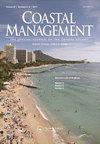Social-Ecological Risk and Vulnerability to Flooding and Erosion along the Ohio Lake Erie Shoreline
IF 1.9
4区 环境科学与生态学
Q4 ENVIRONMENTAL SCIENCES
引用次数: 1
Abstract
Abstract The Laurentian Great Lakes system holds approximately 20% of the world’s available surface freshwater and represents an immense economic engine for the region. Lake Erie, one of the five North American Great Lakes is classified as highly stressed and deteriorating with significant flooding and erosion issues stemming from record-high water levels. This study adapts a well-established oceanic coastal vulnerability index to estimate impacts and risks of lake-level rise on the Ohio portion of Lake Erie coastal social-ecological system. The authors worked closely with coastal engineers, planners, and other practitioners associated with the Ohio Department of Natural Resources (ODNR) and the Office of Coastal Management (OCM) to help adapt a scientifically-grounded framework for natural resource and policy decision making. Overall, place-based risk and vulnerability to flooding and erosion necessitates an integrated approach that combines socio-economic, built-environment, political boundaries, and bio-physical characteristics. While most of the integrated methodologies are focused on the oceanic coasts at the county scale, this research presents a model for Lake Erie-relevant variables at the higher-resolution census-tract unit of analysis and a coastal vulnerability index at 100-foot intervals along the coastline for four decades and each season. The result is both a foundation for Ohio’s Department of Natural Resources, Office of Coastal Management to identify scientifically-informed, place-based priority management areas for flooding and erosion, as well as a methodological roadmap to adapt the Coastal and Place Vulnerability Indices to the other Great Lakes’ states and provincial shorelines.俄亥俄伊利湖岸线对洪水和侵蚀的社会生态风险和脆弱性
劳伦森五大湖系统拥有世界上约20%的可用地表淡水,是该地区巨大的经济引擎。伊利湖是北美五大湖之一,由于创纪录的高水位导致严重的洪水和侵蚀问题,伊利湖被列为高度紧张和恶化的湖泊。本研究采用已建立的海洋海岸带脆弱性指数来评估湖面上升对伊利湖俄亥俄部分海岸带社会生态系统的影响和风险。作者与沿海工程师、规划师以及与俄亥俄州自然资源部(ODNR)和海岸管理办公室(OCM)相关的其他从业人员密切合作,以帮助调整自然资源和政策决策的科学基础框架。总的来说,基于地点的风险和易受洪水和侵蚀的脆弱性需要一个综合的方法,结合社会经济、建筑环境、政治边界和生物物理特征。虽然大多数综合方法都集中在县尺度上的海洋海岸,但本研究提出了一个以更高分辨率的普查区分析单位为伊利湖相关变量的模型,以及一个沿海脆弱性指数,每隔100英尺,沿海岸线40年,每个季节。研究结果为俄亥俄州自然资源部沿海管理办公室确定科学的、基于地点的洪水和侵蚀优先管理区域奠定了基础,也为使沿海和地方脆弱性指数适应其他五大湖州和省级海岸线制定了方法论路线图。
本文章由计算机程序翻译,如有差异,请以英文原文为准。
求助全文
约1分钟内获得全文
求助全文
来源期刊

Coastal Management
环境科学-环境科学
CiteScore
6.00
自引率
0.00%
发文量
24
审稿时长
>36 weeks
期刊介绍:
Coastal Management is an international peer-reviewed, applied research journal dedicated to exploring the technical, applied ecological, legal, political, social, and policy issues relating to the use of coastal and ocean resources and environments on a global scale. The journal presents timely information on management tools and techniques as well as recent findings from research and analysis that bear directly on management and policy. Findings must be grounded in the current peer reviewed literature and relevant studies. Articles must contain a clear and relevant management component. Preference is given to studies of interest to an international readership, but case studies are accepted if conclusions are derived from acceptable evaluative methods, reference to comparable cases, and related to peer reviewed studies.
 求助内容:
求助内容: 应助结果提醒方式:
应助结果提醒方式:


